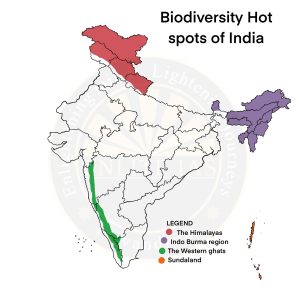Biodiversity Hotspots
- Biodiversity hotspots are geographical areas that exhibit a notable abundance of diverse species, including numerous species that are unique to that specific location and a substantial number of species that are at risk of extinction.
- The notion of biodiversity hotspots was initially introduced in the late 1980s.
- Criteria
- It must have at least 1,500 vascular plants as endemics which is to say, it must have a high percentage of plant life found nowhere else on the planet. A hotspot is irreplaceable.
- It must have 30% or less of its original natural vegetation and must be threatened.
- Hotspots in India
- Himalayan Hotspot
- Indo-Burma Hotspot
- Sundaland
- Western Ghats-Sri Lanka

Hope Spots
- In 2013 Andaman and Nicobar Islands and Lakshadweep islands were named as the “hope spots”.
- This recognition was given by the International Union for Conservation of Nature (IUCN) and Mission Blue, an organisation involved in the study of oceans.
- A Hope Spot is any special place that is critical to the health of the ocean—Earth‘s blue heart.
- It is an area of an ocean that needs special protection because of its wildlife and significant underwater habitats.
- The two groups of islands are the first places in India to have been added in the list of global hope spots.
